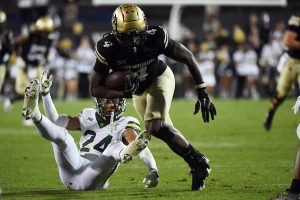
Since the dawn of time, football fans have dreamt of enjoying an alcoholic beverage in view of the pitch. Must we forever suffer under draconian laws which forbid the sacred seat-pint? Cricket, tennis, rugby, the cinema, basically all other parts of public life are laughing at us.
That is how it seems to anyone born from the mid-1970s onwards who is keen on football and alcohol. The ban on terraced boozing was introduced in 1985 with the Sporting Events (Control of Alcohol etc.) Act. It forbids drinking “at any time during the period of a designated sporting event when he is in any area of a designated sports ground from which the event may be directly viewed”.
Also outlawed are bringing alcohol with you into stadiums and entering while drunk, or becoming drunk while there. At a conservative guess this has made criminals of around 80 per cent of all match-going football fans at some point.
The rule is met with incredulity if you take an outsider to a game, whether foreign national or rugby sort. Arguably these regulations belong to the poorly behaved 1980s and do not reflect the changing demographics and behaviours of modern supporters. There is occasional appetite for change to rules that are seen by some as a legislative overreach. Bob Eastwood, the head of security and safety operations in the English Football League, proposed trials in 2023, but chief constable Mark Roberts said calls to end the ban were dangerous and warned MPs of families being soaked in “lager shampoos”.

A small step has been taken this season in the Championship, the second tier of women’s football. Southampton are one of four clubs trialling permitting alcohol in seats. There were hopes that Good Friday would bring accommodating weather as Southampton faced the London City Lionesses at St Mary’s, to test the theory that fans would drink more on a sunny day. The British climate had other ideas.
Rain is whipping off the River Itchen outside and inside take-up for beers is muted. There are more coffee cups than plastic pint pots visible in the seats and the mood is flat after an early goal for the visitors, which Southampton never look likely to recover from. It is tough to generate much of an atmosphere with a crowd of 2,112 in a stadium that holds 32,000.
Nevertheless the trial has been successful so far. “It’s going really well,” says Andy Darbyshire, head of crowd safety and security at Southampton. “What we have seen is that people who do want to take alcohol into the bowl have been very well behaved. We haven’t had any reports of anti-social behaviour, heavy intoxication. The odd spillage, but no more than you have with coffee, tea or hot chocolate.
“There was a slight concern that people would throw their drinks around when goals are scored but speaking to all of the other clubs involved none of us have seen that.”
Southampton do score, and there is indeed no Boxpark historical re-enactment. Partly because it makes the score 1-3, and the Lionesses soon make that 1-4. The limit of mischief is one teenager saying “oh s—” when it looks like the visitors are going to make it five. Otherwise the crowd is sedate.

Southampton fan Jason Hodges is an enthusiastic convert. At Bristol City, another club taking part, he was on the Thatcher’s Gold. “I had three before the game, two during and two at half-time. I was on fine form that day.
“There are a lot of kids at women’s games so I separate myself from them in the stand rather than being behind them shouting. I think if it stays in the women’s game it’ll be all right but there’s talk of extending it to men’s football as well. We get enough trouble as it is without that; there are a lot of idiots that go, get drunk and start kicking off. It’s a different culture.”
His worries are echoed by fellow fan Kate Arnold, although she has seen no issues so far. “I see people walking around with wine glasses, but other than that it’s made no difference to me as a fan,” she says. “It’s not likely to be like rugby fans walking around, beer in hand, it’s a more reserved crowd. They won’t even let me bring in my air horn.
“It would be harder in a bigger crowd, for an England game for example, because there are a lot of younger girls going by themselves, 16-25-year-olds. It would be difficult to police whether they are old enough to be drinking.”
Shortly after half-time the concourse bar shuts, curtailing my evening of hedonism at a disappointing two pints. There is no clear evidence that the trial has changed anything this evening – the test will come with larger crowds. No arrests were reported at women’s football matches during the entirety of the 2023-24 season, while there were 2,584 related to the men’s game.
But it still remains odd that drink-fuelled anti-social behaviour is tolerated at other sporting events. Brawls at racecourses are a social media staple every summer. What makes football so different?

Since the dawn of time, football fans have dreamt of enjoying an alcoholic beverage in view of the pitch. Must we forever suffer under draconian laws which forbid the sacred seat-pint? Cricket, tennis, rugby, the cinema, basically all other parts of public life are laughing at us.
That is how it seems to anyone born from the mid-1970s onwards who is keen on football and alcohol. The ban on terraced boozing was introduced in 1985 with the Sporting Events (Control of Alcohol etc.) Act. It forbids drinking “at any time during the period of a designated sporting event when he is in any area of a designated sports ground from which the event may be directly viewed”.
Also outlawed are bringing alcohol with you into stadiums and entering while drunk, or becoming drunk while there. At a conservative guess this has made criminals of around 80 per cent of all match-going football fans at some point.
The rule is met with incredulity if you take an outsider to a game, whether foreign national or rugby sort. Arguably these regulations belong to the poorly behaved 1980s and do not reflect the changing demographics and behaviours of modern supporters. There is occasional appetite for change to rules that are seen by some as a legislative overreach. Bob Eastwood, the head of security and safety operations in the English Football League, proposed trials in 2023, but chief constable Mark Roberts said calls to end the ban were dangerous and warned MPs of families being soaked in “lager shampoos”.

A small step has been taken this season in the Championship, the second tier of women’s football. Southampton are one of four clubs trialling permitting alcohol in seats. There were hopes that Good Friday would bring accommodating weather as Southampton faced the London City Lionesses at St Mary’s, to test the theory that fans would drink more on a sunny day. The British climate had other ideas.
Rain is whipping off the River Itchen outside and inside take-up for beers is muted. There are more coffee cups than plastic pint pots visible in the seats and the mood is flat after an early goal for the visitors, which Southampton never look likely to recover from. It is tough to generate much of an atmosphere with a crowd of 2,112 in a stadium that holds 32,000.
Nevertheless the trial has been successful so far. “It’s going really well,” says Andy Darbyshire, head of crowd safety and security at Southampton. “What we have seen is that people who do want to take alcohol into the bowl have been very well behaved. We haven’t had any reports of anti-social behaviour, heavy intoxication. The odd spillage, but no more than you have with coffee, tea or hot chocolate.
“There was a slight concern that people would throw their drinks around when goals are scored but speaking to all of the other clubs involved none of us have seen that.”
Southampton do score, and there is indeed no Boxpark historical re-enactment. Partly because it makes the score 1-3, and the Lionesses soon make that 1-4. The limit of mischief is one teenager saying “oh s—” when it looks like the visitors are going to make it five. Otherwise the crowd is sedate.

Southampton fan Jason Hodges is an enthusiastic convert. At Bristol City, another club taking part, he was on the Thatcher’s Gold. “I had three before the game, two during and two at half-time. I was on fine form that day.
“There are a lot of kids at women’s games so I separate myself from them in the stand rather than being behind them shouting. I think if it stays in the women’s game it’ll be all right but there’s talk of extending it to men’s football as well. We get enough trouble as it is without that; there are a lot of idiots that go, get drunk and start kicking off. It’s a different culture.”
His worries are echoed by fellow fan Kate Arnold, although she has seen no issues so far. “I see people walking around with wine glasses, but other than that it’s made no difference to me as a fan,” she says. “It’s not likely to be like rugby fans walking around, beer in hand, it’s a more reserved crowd. They won’t even let me bring in my air horn.
“It would be harder in a bigger crowd, for an England game for example, because there are a lot of younger girls going by themselves, 16-25-year-olds. It would be difficult to police whether they are old enough to be drinking.”
Shortly after half-time the concourse bar shuts, curtailing my evening of hedonism at a disappointing two pints. There is no clear evidence that the trial has changed anything this evening – the test will come with larger crowds. No arrests were reported at women’s football matches during the entirety of the 2023-24 season, while there were 2,584 related to the men’s game.
But it still remains odd that drink-fuelled anti-social behaviour is tolerated at other sporting events. Brawls at racecourses are a social media staple every summer. What makes football so different?






